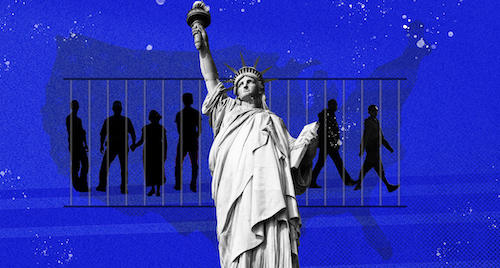Barak, who teaches Crimmigration and Criminal Justice Research Methods at UM-Dearborn, has an educational background in justice and criminology. But her experiences working with migrants and immigrants, as well as U.S. government offices and law enforcement, gives her a layered perspective when it comes to immigration law.
“Immigration policy touches on nearly all other aspects of law and policy from family law to labor law to criminal law. Any judge will tell you that the complexity of U.S. immigration law is perhaps rivaled only by tax law in terms of its many intricacies,” she says. “Perhaps it’s this complexity that leads to the idea that immigrants, documented or undocumented, pose a criminal threat.”
Barak shares a few points to give a better understanding of why deviant behavior and immigration is connected in political rhetoric, news stories and the American consciousness — and offers how research counters these messages.
Crime and immigration have been united in the U.S. mindset for hundreds of years.
History books tell us that Great Britain sent convicted criminals to the “New World” to help establish colonies. But not long after the Revolutionary War, colonists put a stop to that practice. “One of the first moves the founding fathers made after establishing the U.S. was to ban the practice of shipping convicted criminals off to the colonies (1788). In that moment, crime and immigration were forever united in the American mindset,” Barak says. “They no longer wanted it to be considered Britain's dumping ground. They began sending the ships back.”
Adding to that: In 1790, American citizenship became reserved for free white males. Then came the Naturalization Act of 1798, which established the power to deport. “From very early on, we see a distinction between those “deserving” of a life in the U.S. and those deemed “undeserving’.” Barak says notions of who is deserving and undeserving of being part of American society has changed over the years, but the discourse, politics and strategies of exclusion — for the most part — remain the same.
The public and state attention didn’t shift to undocumented immigrants until the late 1960s with the end of the Bracero Program, which was a U.S. laborer contract program with Mexico. “By the mid-1980s, we see the political narratives shifting and the emergence of a moral panic surrounding illegal immigration,” she says. “Research shows that immigrants try to avoid legal confrontations and that undocumented workers often pay taxes, but don’t get benefits. So the panic over fraud and crime is largely unfounded.”
Data shows that immigrants — with or without documentation — commit less crime than established U.S. citizens.
Barak says many of her students are surprised to learn that, for the last century, study after study has demonstrated that immigrants — with or without documentation — offend at lower rates than native-born Americans. She says there are several reasons for this.
First, immigrants don’t want to get in trouble because they have a fear of deportation and generally want to avoid contact with law enforcement. “While doing research for my book project, I met a man who was detained by U.S. Immigration and Customs Enforcement (ICE) and placed on a plane to be deported — only to be taken off the plane because they realized he actually became a U.S. citizen through his mother’s naturalization. As a community organizer, I came across immigrant women who refused to call the police to report domestic abuse because they worried they would be asked if they had papers. All it takes is one story like these in a community to create fear and distrust.”
Second, close-knit communities often have a behavior code or expectations. Research also shows that when looking at two communities of similar economic status, the immigrant one often has less crime than the established American one. “That’s because there’s collective efficacy. People know each other and their families. They often share culture, goals and values. That connectedness leads to an environment where people watch out for each other and will intervene if someone is performing an action that violates community trust.”
Most undocumented people in the U.S. came here legally.
Barak says another common misconception is that immigrants who are living in the U.S. without documentation didn’t come here “the right way.” Of the 10.5 million undocumented people living in the U.S. today, more entered the country with authorization — arrived via plane with a valid visa and passport or drove through a border checkpoint — than without.
So how did these people end up without a valid immigration status? Barak says some failed to renew their visas on time or missed an appointment. “That can result from something as seemingly insignificant as a piece of important mail from United States Citizenship and Immigration Services winding up lost or at the wrong address,” she says. Others come to the U.S. with non-immigrant visas — meaning temporary visas that do not have a pathway to citizenship — like a student visa and overstay the visa expiration date. Although it is often cited as a reason for closed borders, Barak says only a very small number of immigrants lose their authorization to live, work, study or travel in the U.S. due to a criminal conviction.
Immigration is a federal issue that should transcend political labels.
Barak stresses that immigration — which is a federal-level issue — goes beyond conservative and progressive points of view. “Sometimes it’s important to remember that crime and crime control are things that we’ve created, as are terms like conservative and progressive. If we took labels off and politicians stopped worrying about being ‘too conservative’ or ‘too progressive’ we may have more success in our immigration policies.”
She says often local law enforcement officers are tasked with enforcing federal laws, which in turn can put them at odds with immigrants in the communities they serve. “Local officers have to enforce, or at least comply with, federal immigration laws,” she says. So if you want change, Barak says go to people with connections at the top.
She suggests a few actions to take. Write a letter to your congressperson. Keep educating yourself by seeking out a variety of perspectives on immigration law. And volunteer for immigrant rights focused organizations; She’s involved with Justice For Our Neighbors and the organization has partnered with Barak’s Crimmigration course for an Academic Service Learning Project.
Barak says education is key. She’s proud to have students graduate and land positions in local and federal law enforcement and legal fields. And she hopes they take a fuller understanding of American law and immigration with them.
Interview by Sarah Tuxbury. If you’re a member of the media and would like to interview Assistant Professor Maya Barak about this topic, please drop us a line at UMDearborn-News@umich.edu.





